Post by Willie for Notes from Africa

The Brandberg Massif from the south at sunset. (Image By Joel Holdsworth, Wikimedia Commons )
Another fascinating place in Namibia is the Brandberg Mountain. Situated in the north-western area of the Namib (Damaraland), the Brandberg Massif is a granite intrusion which forms a dome-shaped massif. It is huge covering approxing 650 km², with its highest point being at 2573 metres (8442 feet) about sea-level. On a clear day it can be seen towering over the Namib gravel plains from a great distance. You can read more about its geology here.
The name Brandberg is Afrikaans, Dutch and German for ‘Fire Mountain’, which comes from its glowingcolour which is sometimes seen in the setting sun. The Damara name for the mountain is Dâures, which means ‘burning mountain’, while the Herero name, Omukuruvaro means ‘mountain of the Gods’.

Satellite image (Landsat 7) of the Brandberg Massif. Image source: Wikimedia Commons.
Besides being an impressive structure, the area around the Brandberg mountain has some other unique features. The desert flora here (including aloe and euphorbia species) has to survive in the extreme climatic conditions. There are 11 plant taxa which are endemic to the Brandberg. The area is uninhabited and wild, and although there is a large diversity of wildlife, animal populations are small because of the lack of water. This area is known for the desert elephants. Although we never saw any while we were there, we were reminded that they roamed these parts by road signs such as the one below. Having lived in Southern Africa my whole life, a sign like this is not a common occurrence outside of a wildlife reserve.

Beware of roaming elephants! ©LB/notesfromafrica.wordpress.com
Most rock art sites in Namibia are located along the country’s broken longitudinal escarpment. Hunter-gatherers set out from these sites into the desert during the brief and unpredictable summer rains. A pattern of social aggregation and dispersal became established during the last 5 000 years, as a finely tuned human response to increasing aridity.

This map shows the distribution of rock art sites along Namibia’s escarpment. The cluster of sites towards the north, closest to the coast represents the concentration of rock art found at Brandberg. Map source: UNESCO document
The Brandberg is a significant spiritual site to the San (Bushman) tribes. In the Tsisab Ravine at the foot of the mountain, there are more than 1000 rock shelters, with more than 45 000 rock paintings [Wikipedia]. The most well-known of the rock paintings is The White Lady, which is a major tourist attraction at Brandberg.
The subject in this iconic painting has been the source of controversy for quite some time. From analogies to paintings of athletes in Crete, travelers from the Mediterainean area, as well as being Phoenician in origin. The commonly accepted explanation of the painting is as follows.
It is usually assumed that the painting shows some sort of ritual dance, and that the “White Lady” is actually a medicine man. She has white legs and arms, which may suggest that his body was painted or that he was wearing some sort of decorative attachments on his legs and arms. He holds a bow in one hand and perhaps a goblet in the other. Because of the bow and the oryxes, the painting has also been interpreted as a hunting scene.
I was lucky enough to visit the location of The White Lady at the cave known as “Maack Shelter”. You have to go with a guide who gets you there and back and tells you about the interesting scenery on the walk to the Maack Shelter. It certainly is still a wilderness area – we were the first ones up the path that morning and found some fresh leopard spoor (tracks) along the way.

My guide ©WMB/notesfromafrica.wordpress.com

Leopard spoor on the trail ©WMB/notesfromafrica.wordpress.com

©WMB/notesfromafrica.wordpress.com
The paintings are now protected but you can get close enough to take some photographs of the large panels depicting Oryx and the shaman.

The White Lady painting ©WMB/notesfromafrica.wordpress.com

Mural of the hunting scene – The White Lady is to the right in the centre. ©WMB/notesfromafrica.wordpress.com
There are many interesting sections to this mural.

A larger portion of the mural – showing more figures with white legs and another shaman at the bottom, second from the left.©WMB/notesfromafrica.wordpress.com

Painting of Oryx with human rear legs. It is believed that while in a state of trance the medicine man could take on the spirit of a particular animal that was relevant to the ceremony. The use of the Oryx in this case being a call for rain. [Namibia 1-on-1] ©WMB/notesfromafrica.wordpress.com

Painting including zebra. ©WMB/notesfromafrica.wordpress.com

Painting of Blue Wildebeest. ©WMB/notesfromafrica.wordpress.com

Painting of strange skeleton-like figure. ©WMB/notesfromafrica.wordpress.com
The guide also showed me some paintings closer to the car park, but the quality was not the same as the those at Maack Shelter.

Painting of elephant ©WMB/notesfromafrica.wordpress.com
“The bushmen artists ground iron-rich rock (Hematite) for their red paint; ochre for the yellows; charcoal and manganese for the black; calcium carbonate for the white. Blood serum, egg white and casein were used as binding agents” [Namibia 1-on-1]. It is amazing to think that paint with a binding agent of blood and or egg white could lasts thousands of years.
For the preservation of the other paintings access to many areas on the mountain is limited. There must be many more amazing rock paintings on this mountain.
This post is part of a series I will be publishing about our travels through Namibia.







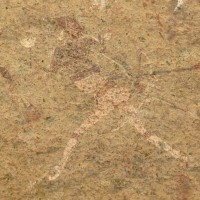
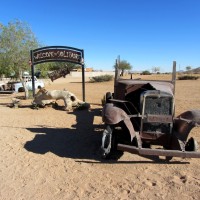


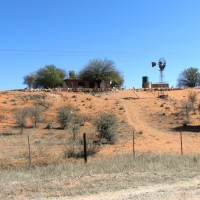
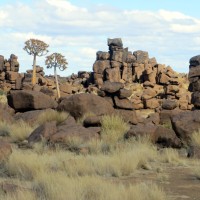
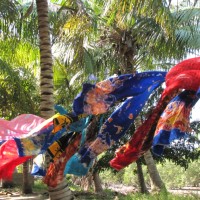
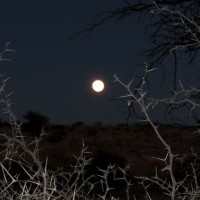
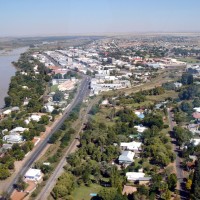


I love those elephant crossing sings. One of my favorite photos I took in Namibia.
Lisa has got a good eye for catching signs like that – and they aren’t just idle threats!
We have a couple of elephants hiding in the forests here in the Southern Cape. They seem to hate road signs – while I have never seen the elephants themselves they often cause damage to road signs and forestry equipment.
This post is full of interesting knowledge, elephants in South Africa, leopards, and the greatest of all, the wall paintings. It is amazing to think of those artists at that time, did they realize that the paintings are still there for us to see. Here in Finland, we have also wall paintings, and they have the same idea, stories of hunting, shamans, paintings of important things in their life.
Thanks, you have interpreted the post and the elements of the the paintings very well. Bearing in mind that they used substances like blood and egg-white in the paints its is remarkable that the pictures have lasted that long. Having looked at other rock art paintings here in the Southern Cape, the detail and use of colours in The White Lady paintings are extraordinary.
What strikes me as universal is the role of trance dancing and the important role it played in ancient art.
Wow, did I read that correctly — there are 45,000 of these paintings in the area? That’s astounding! They are lovely and so well preserved. I wonder if the climate helps keep the drawings in such good condition.
Hi Jackie, yes those are the numbers of paintings acording to the great god of knowledge (Wikipedia). Other sources also mention very large numbers of paintings in this and other areas in the proximity. (Maybe they are counting each individual figure?) Must have been a busy group of painters! The dry climate must have played a role in preserving the paintings, but the practice of wetting the paintings to highlight the colours for photography purposes did not help. The barriers in front of the paintings are now there for a very good reason.
fascinating!
Thanks for visiting and leaving a comment! 🙂
These rock paintings are quite extraordinary. I too did not realise that there were *that* many sites! I guess many of them aren’t open to tourists, probably just as well… I am glad that they are protecting these ones so much better than in the past. I’ve also never seen an aerial photo of the Brandberg – didn’t know it looked so circular from above!
The Brandberg is awesome isn’t it? I read somewhere that the early mariners used it as a navigation point. “In the days of sail a mountain on the eastern horizon, inland from the featureless shore of the land that would become Namibia, served as a landmark of sorts for mariners on voyages of discovery. If they had been able to approach it with the light of the setting sun behind them, they would have witnessed its granite slopes turning a fiery red. The local people called it Dâµ²es or Burning Mountain.” – From here.
I wonder whether they were counting individual sites – or individual figures painted on rock in that area?
Ha! I learn so much by reading your blog, Lisa! 🙂
I can’t imagine them counting individual figures… perhaps it’s clusters of figures that belong together thematically, or that are in close proximity to each other?
Wow..I wonder what the significance of the white bits were. A very small part of my mind piped up, “Artistic License’ which, I am sure is not the case. I am grateful they are protecting these works. I fear there are cultures that would destroy them if they were thought to hold religious significance and then there are vandals.
These are fascinating, thanks for sharing.
The white bits? On the animals or human figures? The Brandberg is fairly remote so hopefully that deters any would be vandals.
Thanks for visiting and leaving a comment! 🙂
I went to that place of ‘Was it an albino human’ but then I think of places in Eastern and Southern Africa where Albinos are in danger from their non-albino neighbors who kill them because of the belief their cut up body parts are strong medicine.
The debate is whether or not they are depicting Europeans in their paintings. Or maybe they painted a white substance such as clay on their bodies?